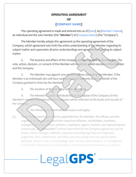What to Do When You're Asked to Sign a One-Sided Contract
You’re a freelancer, thrilled to land a big client, but their contract arrives, and it’s a red-flag parade: they can cancel anytime, you’re liable...
12 min read
LegalGPS : Jun. 17, 2025
Every legal professional faces the uncomfortable reality at some point in their career: not every client relationship works out. Despite your best efforts, some client relationships become more costly than beneficial—financially, operationally, and emotionally.


Legal GPS Pro
Protect your business with our complete legal subscription service, designed by top startup attorneys.
Learning to identify these situations and address them professionally isn't just good business; it's essential for maintaining your firm's health and your own wellbeing.
This guide will walk you through the delicate process of terminating a client relationship while maintaining professionalism, ethical standards, and minimizing disruption to all parties involved.
The decision to end a client relationship should never be taken lightly, but certain patterns indicate when it's the necessary choice. Recognizing these signs early can save significant stress and resources.
Problem clients often display multiple warning signs. They may consistently pay late or dispute reasonable bills. They might repeatedly ignore your advice or withhold crucial information.
Some demand immediate responses at all hours but take days to reply to your inquiries. Others may speak disrespectfully to you or your staff, creating a toxic work environment.

Service Agreement Template
Download our general Service Agreement Template to streamline client onboarding and protect your services with clear terms.
Trusted by 1,000+ businesses to safeguard their LLCs.
The financial impact extends beyond unpaid invoices. Consider the opportunity cost—the profitable clients you could be serving instead.
Research from legal management consultants suggests that the most problematic 10% of clients often consume 50% of non-billable administrative time while generating only 20% of revenue.
The emotional and operational toll compounds over time. Staff morale suffers when dealing with difficult personalities. Team members may avoid working on certain matters, creating workflow bottlenecks.
Your own professional satisfaction diminishes, potentially affecting work quality across all your cases.
Common warning signs that it might be time to terminate a client relationship include:
A small business law firm took on a startup client who initially needed help with incorporation and basic contracts. Over time, the client began requesting "quick advice" on matters ranging from employment issues to intellectual property—often after hours—expecting immediate responses without formal engagement for these additional matters.
Despite conversations about expanding the scope of representation properly, the pattern continued. The managing partner realized they were exposed to significant liability by providing casual advice outside their formal engagement, while the client resisted proper engagement for the additional matters.
After calculating that the client's matters had the lowest realization rate in the firm while consuming disproportionate attention, they made the difficult decision to terminate the relationship.
Once quarterly, review your client roster for profitability and resource consumption. Create a simple matrix with four quadrants: high profit/low maintenance, high profit/high maintenance, low profit/low maintenance, and low profit/high maintenance.
Clients in the last category deserve special scrutiny. For each, calculate not just billable hour realization but total hours (including non-billable time) spent servicing them.
This data-driven approach removes emotion from the equation and clearly identifies which relationships may need reconsideration.
Once you've decided termination is necessary, thorough preparation is essential for a smooth transition. This preparation phase is not just about gathering documents; it's about ensuring you can fulfill your ethical obligations while protecting your practice.
Start by documenting the history of issues with the client. Gather evidence of missed payments, inappropriate communications, or instances where the client disregarded legal advice.
Review your previous attempts to address these issues, including emails, memos from meetings, or file notes documenting verbal conversations.
Next, carefully review your engagement letter and any other contractual agreements. Most well-drafted engagement letters include provisions for termination of representation.
Understand what notice periods apply and what conditions must be met. In some practice areas, such as litigation, you may need court approval to withdraw, which requires additional planning.
Address any financial matters before the termination meeting. Generate a final invoice capturing all work performed to date. Review trust account balances if applicable, ensuring you can clearly explain any remaining funds or outstanding balances.
Prepare to discuss payment arrangements for any unpaid fees.
Perhaps most importantly, develop a transition plan for the client's legal matters. Identify upcoming deadlines or statutes of limitations. Prepare a list of recommended next steps for the client, including potential referrals to other attorneys who might be more suitable for their needs.
Pre-termination preparation checklist:
A family law attorney needed to terminate representation with a client who repeatedly failed to provide necessary financial documentation for their divorce case, then blamed the attorney for delays.
Before the termination meeting, the attorney prepared a comprehensive transition packet including: a timeline showing repeated requests for documents, a calendar highlighting critical upcoming deadlines, three referrals to other family law practitioners, detailed instructions for transferring the file, and a clear accounting of the retainer usage.
This thorough preparation transformed what could have been a confrontational meeting into a professional transition, with the client ultimately acknowledging their role in the breakdown of the relationship.
Develop a standardized checklist for client terminations that covers all ethical and practical considerations. Include items like: court notification requirements, file organization protocols, final billing procedures, and client notification timelines.
Having this systematic approach ensures nothing falls through the cracks during what can be an emotionally charged process. It also helps distribute the workload among team members and creates consistency in how terminations are handled.
The conversation itself requires careful handling. How you conduct this discussion can dramatically impact whether the termination occurs smoothly or devolves into a contentious situation with potential repercussions.
Choose the right setting and timing. Schedule a specific meeting for this purpose rather than tacking it onto another matter. Consider timing—avoid notifying a client immediately before a holiday weekend or major personal event if you're aware of one.
While in-person meetings were traditionally preferred, video conferences can be effective alternatives when distance is a factor.
Begin the conversation with clarity and professionalism. Use straightforward language that focuses on the attorney-client relationship rather than personal criticisms.
Phrases like "our working relationship isn't optimally serving your legal needs" are preferable to "you're impossible to work with." Frame the decision as final rather than negotiable—opening the door to negotiation often prolongs an uncomfortable situation without changing the ultimate outcome.
Anticipate emotional reactions and prepare to respond calmly. Some clients may express anger, attempt to negotiate, or make promises to change problematic behaviors. Others might respond with relief, having also recognized the misalignment.
Regardless of their reaction, maintain your professional demeanor and avoid being drawn into arguments or reconsidering your decision.
Clearly outline the next steps for both parties. Explain how their matter will be handled during the transition period, how files will be transferred, and what deadlines require attention. Provide this information both verbally and in writing through a formal disengagement letter that will follow the meeting.
Effective language to use during termination conversations:
An intellectual property attorney needed to terminate a relationship with a client who had developed a pattern of public social media criticism of the attorney's strategy, despite the attorney's repeated explanations about legal requirements for trademark applications.
During the termination meeting, the attorney calmly explained: "Based on your public statements, it appears you're dissatisfied with our legal strategy, despite our explanations of the USPTO requirements. This fundamental disagreement about approach suggests you would be better served by an attorney whose strategy aligns more closely with your expectations."
The attorney then provided a detailed transition timeline and referrals to three other IP attorneys. By focusing on the strategic misalignment rather than the client's behavior, the attorney maintained professionalism while clearly communicating the reason for termination.
Before the termination meeting, write out your primary talking points and anticipated client questions. While you shouldn't read from a script, having carefully considered language helps you avoid potentially problematic statements when emotions run high.
Practice your delivery with a colleague to identify any phrasing that could be misinterpreted or unnecessarily provocative. Remember that in tense situations, how something is said often matters as much as what is said.
Terminating client relationships carries significant ethical obligations that vary by jurisdiction. Understanding these requirements is non-negotiable for protecting both the client's interests and your professional standing.
Familiarize yourself with your jurisdiction's specific rules regarding withdrawal from representation. Most states base their requirements on variations of Model Rule 1.16 of the Professional Rules of Conduct, which outlines both mandatory and permissive withdrawal circumstances.
Pay particular attention to timing requirements and circumstances requiring court approval.
Client file handling requires careful attention. Determine what documents belong to the client versus what constitutes your work product under your jurisdiction's rules. Prepare the file for transfer, ensuring it's well-organized and complete.
Consider whether electronic or physical transfer is more appropriate based on file size and client capabilities.
Confidentiality obligations continue after termination. Remind all staff members that the former client's information remains protected by attorney-client privilege and confidentiality rules.
This includes refraining from discussions about the client with others, even after the relationship ends.
Take special precautions to avoid abandonment claims. Ensure the client has reasonable time to secure new counsel, particularly if there are pending deadlines. In some circumstances, you may need to request extensions or continuances to protect the client's interests during the transition.


Legal GPS Pro
Protect your business with our complete legal subscription service, designed by top startup attorneys.
Key ethical considerations during client termination include:
A litigation attorney representing a client in an ongoing civil matter determined that withdrawal was necessary after the client repeatedly instructed the attorney to pursue frivolous motions that lacked legal merit.
The attorney first filed a motion with the court requesting permission to withdraw, carefully drafting it to explain the irreconcilable differences without revealing confidential information or unnecessarily prejudicing the client.
After receiving court approval, the attorney provided the client with the complete file, a detailed case status memo highlighting all upcoming deadlines, and a list of pending discovery issues requiring attention. The attorney also offered to speak directly with the client's new counsel to ensure a smooth transition.
This methodical approach fulfilled ethical obligations while protecting the client's legal interests during the transition.
Develop a comprehensive reference document specific to your jurisdiction's withdrawal requirements. Include statutory references, relevant case law, and practical procedural notes such as which judges typically require hearings for withdrawal motions versus those who rule on the papers.
Update this document annually to capture rule changes or new interpretative cases. This resource becomes invaluable when withdrawal situations arise, allowing you to move quickly with confidence that you're meeting all ethical requirements.
What happens after client termination is just as important as the termination itself. This phase offers valuable opportunities for practice improvement and prevention of similar situations.
Conduct an internal debrief with relevant team members. Discuss what signs were missed during client intake, how problematic behaviors developed, and whether earlier interventions might have salvaged the relationship.
Document these insights without placing blame—the goal is improvement, not accusation.
Review and potentially refine your client intake procedures. Consider whether additional screening questions, different engagement letter provisions, or modified conflict checks might have identified this client as problematic before engagement.
Many firms implement "client acceptance committees" to provide objective review of potential engagements following difficult client experiences.
Adjust firm policies based on lessons learned. Perhaps you need clearer boundaries around communication expectations, more structured onboarding to set expectations, or modified billing practices to reduce payment issues.
Use this experience as a catalyst for positive change within your practice.
Don't overlook the importance of self-care and team support. Terminating client relationships, even when necessary, creates stress. Acknowledge the emotional impact and ensure both you and your team have appropriate outlets to process the experience.
Post-termination improvement opportunities:
A mid-sized corporate law firm terminated a relationship with a client who had become increasingly verbally abusive to support staff while insisting on immediate partner attention for routine matters.
After the termination, the managing partner convened a "lessons learned" session. The team identified that the client had exhibited concerning behavior during initial consultations, but these warning signs weren't communicated to firm leadership before engagement.
The firm implemented a new intake protocol where all client-facing staff could confidentially flag concerning interactions during the consultation phase, creating an early warning system for potentially problematic relationships.
Additionally, they added explicit language to their engagement letter regarding expected communication standards and consequences for abusive behavior. Within six months, the firm had declined two potential engagements based on red flags identified through this new system, likely avoiding future problematic relationships.
Develop a standardized review form to complete after each client termination. Include sections for financial impact analysis (comparing collected fees versus time invested), relationship timeline (when issues first appeared and how they progressed), intervention attempts and their outcomes, and specific lessons for future application.
This systematic approach transforms each termination from merely an unpleasant experience into a valuable learning opportunity that strengthens your practice management approach.
The most effective way to handle difficult client terminations is to prevent them entirely through improved client selection and relationship management.
Refine your initial consultation process to better identify red flags. These might include prospects who have changed attorneys multiple times, express unrealistic expectations despite clarification, demonstrate controlling behaviors during initial meetings, or show disrespect to staff.
Trust your instincts—many attorneys report having an early sense about problematic clients that they later wished they had heeded.
Set clear expectations from the very beginning of the relationship. Well-crafted engagement letters should clearly outline not just scope of representation and fees, but communication protocols, document response timelines, and the circumstances under which the relationship may need to be reconsidered.
Review these provisions verbally during client onboarding rather than merely relying on the client to read the document.
Implement effective communication strategies throughout the relationship. Regular check-ins, clear explanations of legal strategies, and prompt addressing of concerns can prevent minor issues from escalating into relationship-ending problems.
Document these communications in your case management system.
Consider implementing regular client relationship reviews. Quarterly assessments of all active matters can help identify developing issues before they become irreparable. These reviews should examine not just case progress but relationship health indicators like communication quality and adherence to mutual expectations.
Preventive measures to adopt in your practice:
An estate planning attorney implemented a "mutual expectations" document that all new clients receive during their initial consultation. This two-page addendum to the engagement letter outlines in plain language what the client can expect from the firm (response times, communication methods, billing frequency) and what the firm expects from clients (timely document provision, transparent financial disclosure, respectful communication).
The document includes specific examples of how these expectations work in practice. During onboarding, clients review this document with the attorney, ask questions, and sign to acknowledge understanding.
Since implementing this approach, the firm has seen a 70% reduction in client relationship issues and has only terminated one client relationship in three years—a significant improvement from previous experience.
After the initial consultation but before fully committing to representation, schedule a brief follow-up meeting or call with potential clients. This "second date" provides an opportunity to assess how well the prospect follows through on initial requests (like bringing specific documents or completing intake forms), gives you a second impression of their communication style, and allows both parties to raise any concerns that arose after the initial meeting.
This additional touchpoint requires minimal time investment but can save enormous headaches by revealing potential issues before engagement letters are signed.
Firing a client is never enjoyable, but handling it professionally transforms a potentially negative situation into an opportunity for practice growth and refinement.
By recognizing the signs of a troubled relationship early, preparing thoroughly for the termination process, adhering to ethical obligations, learning from the experience, and implementing preventive measures, you build a stronger, more sustainable practice.
Remember that maintaining a healthy practice sometimes requires difficult decisions. The clients you choose not to work with can be as important to your success as those you retain.
Each client relationship should contribute positively to your professional practice—financially, operationally, and psychologically.
The most successful legal professionals view client selection and relationship management as ongoing skills to develop rather than one-time decisions. By approaching these areas with intention and learning from each experience, you create a practice that better serves both your clients and yourself.
The biggest question now is, "Do you need a lawyer for your business?” For most businesses and in most cases, you don't need a lawyer to start your business. Instead, many business owners rely on Legal GPS Pro to help with legal issues.
Legal GPS Pro is your All-In-One Legal Toolkit for Businesses. Developed by top startup attorneys, Pro gives you access to 100+ expertly crafted templates including operating agreements, NDAs, and service agreements, and an interactive platform. All designed to protect your company and set it up for lasting success.

Legal GPS Pro
Protect your business with our complete legal subscription service, designed by top startup attorneys.
|
Premium Template
Single-use Template |
Legal GPS Pro
Unlimited Access, Best Value |
|
|
| Choose Template | Learn More |
| Trusted by 1000+ businesses | |

You’re a freelancer, thrilled to land a big client, but their contract arrives, and it’s a red-flag parade: they can cancel anytime, you’re liable...

You’re scrolling through LinkedIn when you spot a post: your top salesperson, still on your payroll, is boasting about their new role at a rival...

You run a small retail store, and an employee’s chronic underperformance—missed shifts, customer complaints—is dragging down your team. You’re ready...